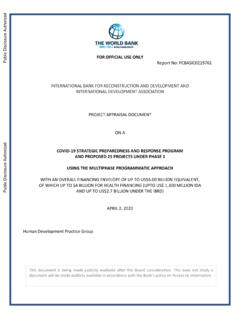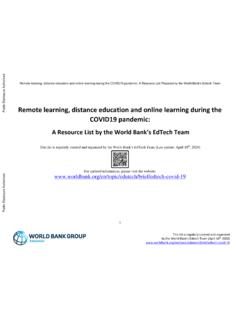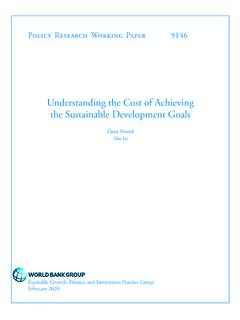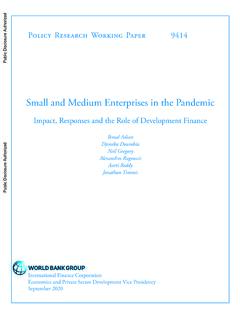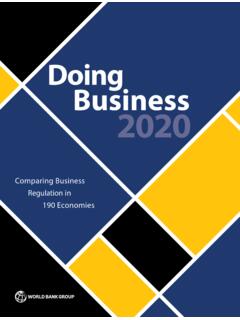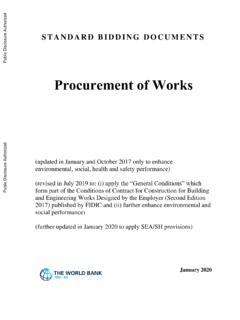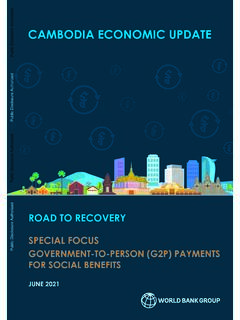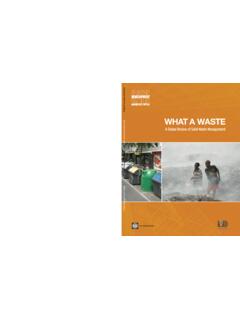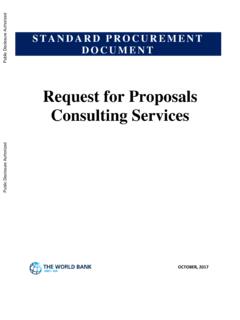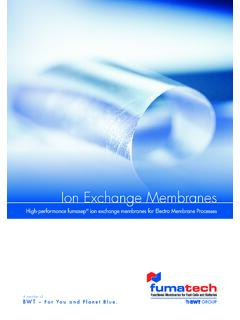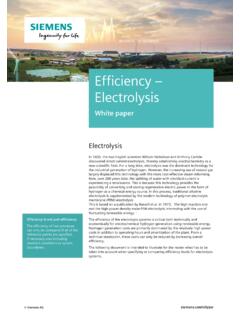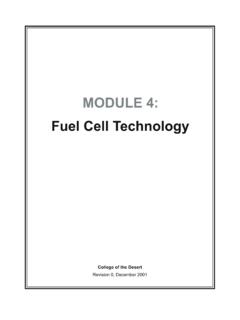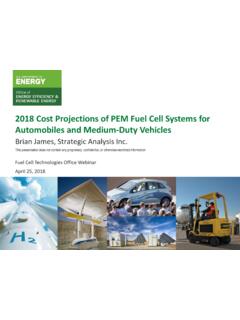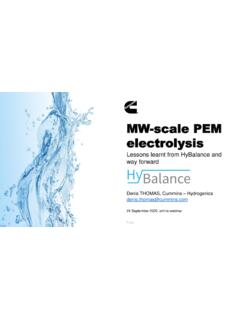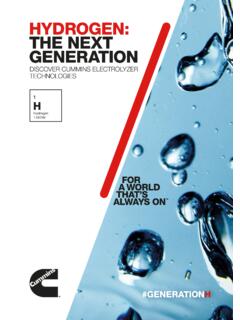Transcription of GREEN HYDROGEN IN DEVELOPING COUNTRIES
1 Public Disclosure Authorized Public Disclosure Authorized Public Disclosure Authorized Public Disclosure Authorized GREEN HYDROGEN IN. DEVELOPING COUNTRIES . This report was researched and prepared by staff and consultants at the Energy Sector Management Assistance Program (ESMAP), part of the World Bank. The work was funded by ESMAP and the World Bank. The authors and main contributors to the report were Fernando de Sisternes (Task Team Leader and Energy Specialist, ES- MAP) and Christopher Jackson (Consultant, ESMAP). The authors thank peer reviewers Demetrios Papathanasiou (Practice Manager, World Bank), Rafael Ben (Energy Specialist, World Bank), Peter Mockel (Principal Industry Specialist, IFC), Pierre Audinet (Lead Energy Specialist, World Bank), Manuel Millan (Senior Energy Special- ist, World Bank), Gabriela Elizondo (Senior Energy Specialist, World Bank), Daniel Roberts (CSIRO), Jenny Hayward (CSIRO), Chris Munnings (CSIRO), and Jenifer Baxter (IMechE), who gave their time and comments to drafts of this report.
2 The authors wish to express their gratitude to Rohit Khanna (Practice Manager, ESMAP), Zuzana Dobrotkova (Senior Energy Specialist, ESMAP), Ivan Jaques (Senior Energy Specialist, ESMAP), Sandra Chavez (Consultant, ESMAP), and Elizabeth Minchew (Associate Operations Officer, IFC) for their valuable comments throughout different stages of this report. The authors also wish to thank Marjorie Araya (Program Assistant, ESMAP), Pauline Chin (Senior Program Assistant, ESMAP), and Melissa Taylor (Program Assistant, ESMAP) for their invaluable support, and Ashley Young (Publications Professionals), Linda Stringer (Publications Professionals), Marcy Gessel (Publications Professionals), and Debra Naylor (Naylor Design) for their editorial and design work.
3 2020 International Bank for Reconstruction and Development/The World Bank 1818 H Street NW, Washington, DC 20433 | USA 202-473-1000 | This work is a product of the staff of the World Bank with external contributions. The findings, interpretations, and conclusions expressed in this work do not necessarily reflect the views of the World Bank, its Board of Executive Directors, or the governments they represent. The World Bank does not guarantee the accuracy of the data included in this work. The boundaries, colors, denominations, and other information shown on any map in this work do not imply any judgment on the part of the World Bank concerning the legal status of any territory or the endorsement or acceptance of such boundaries. RIGHTS AND PERMISSIONS.
4 The material in this work is subject to copyright. Because the World Bank encourages dissemination of its knowledge, this work may be reproduced, in whole or in part, for noncommercial purposes as long as full attribution to this work is given. Any queries on rights and licenses, including subsidiary rights, should be addressed to: World Bank Publications, World Bank Group, 1818 H Street NW, Washington, DC 20433, USA; fax: 202- 522-2625; ESMAP would appreciate a copy of or link to the publication that uses this publication for its source, addressed to ESMAP Manager, World Bank, 1818 H Street NW, Washington, DC 20433 USA; All images remain the sole property of their source and may not be used for any purpose without written permission from the source.
5 Attribution Please cite the work as follows: ESMAP. 2020. GREEN HYDROGEN in DEVELOPING COUNTRIES . Washington, DC: World Bank. Front Cover: Ad Astra Rocket Back Cover: Geoff Brown/AngloAmerican ii GREEN HYDROGEN IN DEVELOPING COUNTRIES . CERES POWER. ESMAP MISSION. The Energy Sector Management Assistance Program (ESMAP) is a global knowledge and technical assistance program administered by the World Bank. ESMAP assists low- and middle-income coun- tries in increasing their know-how and institutional capacity to achieve environmentally sustainable energy solutions for poverty reduction and economic growth. ESMAP is funded by Australia, Austria, Canada, Denmark, the European Commission, Finland, France, Germany, Iceland, Italy, Japan, Lithuania, Luxembourg, the Netherlands, Norway, the Rocke- feller Foundation, Sweden, Switzerland, the United Kingdom, and the World Bank.
6 SFC. CONTENTS. EXECUTIVE SUMMARY .. xi ABBREVIATIONS AND ACRONYMS .. viii GLOSSARY OF TERMS.. ix 1: INTRODUCTION .. 1. 2: WHY GREEN HYDROGEN , WHY NOW, AND WHY DEVELOPING COUNTRIES ? .. 9. Why GREEN HYDROGEN ?.. 10. Why now?.. 11. Why DEVELOPING COUNTRIES ? .. 16. Short-term, medium-term, and long-term opportunities for GREEN HYDROGEN .. 25. 3: STATE OF THE MARKET.. 27. How fuel cell and electrolyzer technologies work.. 28. Market size.. 31. Costs .. 36. 4: ENERGY APPLICATIONS AND COMMERCIAL SOLUTIONS .. 45. Residential applications.. 46. Back-up power applications.. 48. Off-grid power applications.. 49. Commercial applications.. 51. Utility-scale applications.. 53. Levelized cost of energy illustrative modeling: GREEN HYDROGEN production and fuel cell system.
7 55. 5: MOBILITY APPLICATIONS .. 59. Fuel cell electric vehicles .. 61. Fuel cell electric buses .. 62. Shipping and trains.. 67. HYDROGEN refueling stations .. 70. Material handling and forklifts .. 72. 6: INDUSTRIAL APPLICATIONS.. 76. Iron and steel.. 76. Ammonia.. 77. Refining.. 79. Glass, food, and other areas .. 79. Other HYDROGEN fuels.. 80. 7: IMPLEMENTATION CHALLENGES.. 83. Implementation capacity and infrastructure requirements.. 84. Getting the right inputs .. 90. Transport and storage.. 93. 8: AREAS FOR FURTHER RESEARCH.. 99. BIBLIOGRAPHY.. 101. v LIST OF FIGURES. : Primary HYDROGEN and fuel cell applications and ecosystem for DEVELOPING COUNTRIES .. xvi : HYDROGEN South Africa solar plus battery, HYDROGEN electrolysis, and fuel cell system.
8 Xix : Global HYDROGEN market, by production method .. 3. : GREEN HYDROGEN generation and fuel cell examples: Electrolyzer and community wind site, Shapinsey, Orkney Islands, United Kingdom (left) and Bloom Energy commercial unit, United States (right) .. 6. : OECD RD&D Spending, US$, millions, 2001 17.. 12. : World's Largest Electrolyzer: Norsk Hydro 135 MW Electrolyzer, Glomfjord, Norway .. 13. : Lifetime Performance of Siemens-Westinghouse SOFC Units, Test Results .. 14. : World's largest current electrolyzer (25 MW), polysilicon plant, Sarawak, Malaysia.. 19. : Fuel cells for critical infrastructure in Indonesia .. 22. : Commercial fuel cell installation in India .. 24. : Simple diagram of a proton exchange membrane fuel cell .. 28.
9 : Simplified diagrams of a PEM and alkaline electrolyzer .. 30. : Projections and roadmaps for global HYDROGEN in the energy sector demand.. 31. : Power to gas, wind to HYDROGEN in Germany .. 32. : Electrolyzer gigafactory under construction in Sheffield, United Kingdom .. 34. : Technology deployment curves for fuel cells versus wind, and solar photovoltaic.. 35. : Average fuel cell electrical efficiencies between 2005 and 2019.. 36. : Spread in United States HYDROGEN prices from HyDRA, April 2019.. 38. : ITM PEM electrolyzer, National Physics Lab, United Kingdom, 2019 (left) and Siemens Silyzer 3000, Mainz Park, Germany, 2019 (right).. 41. : Stationary PEM fuel cell cost.. 42. : Reported equipment cost decline curves from leading fuel cell suppliers.
10 43. : Examples of residential fuel cell systems.. 47. : Phi Suea off-the-grid house, Thailand, HYDROGEN systems.. 48. : HYDROGEN boilers deployed at Shapinsey School, Kirkwall, United Kingdom .. 49. : Snapshot of portable fuel cells for telecom applications: GenCell A5 2019 (right), SFC Energy methanol fuel cell 2019 (center), and SFC Energy methanol fuel cell back-up for lighting system 2019 (left).. 51. : Utility-scale fuel cell solutions: Solid oxide fuel cell units in the US .. 54. : PEM fuel cell 1 MW unit using excess HYDROGEN from island refinery, Martinique, 2019 .. 56. : Illustrative levelized cost of energy of GREEN HYDROGEN -based electricity, modeling under three scenarios, $/MWh.. 56. : California monthly fuel cell electric vehicle market, January 2014 December 2019.
